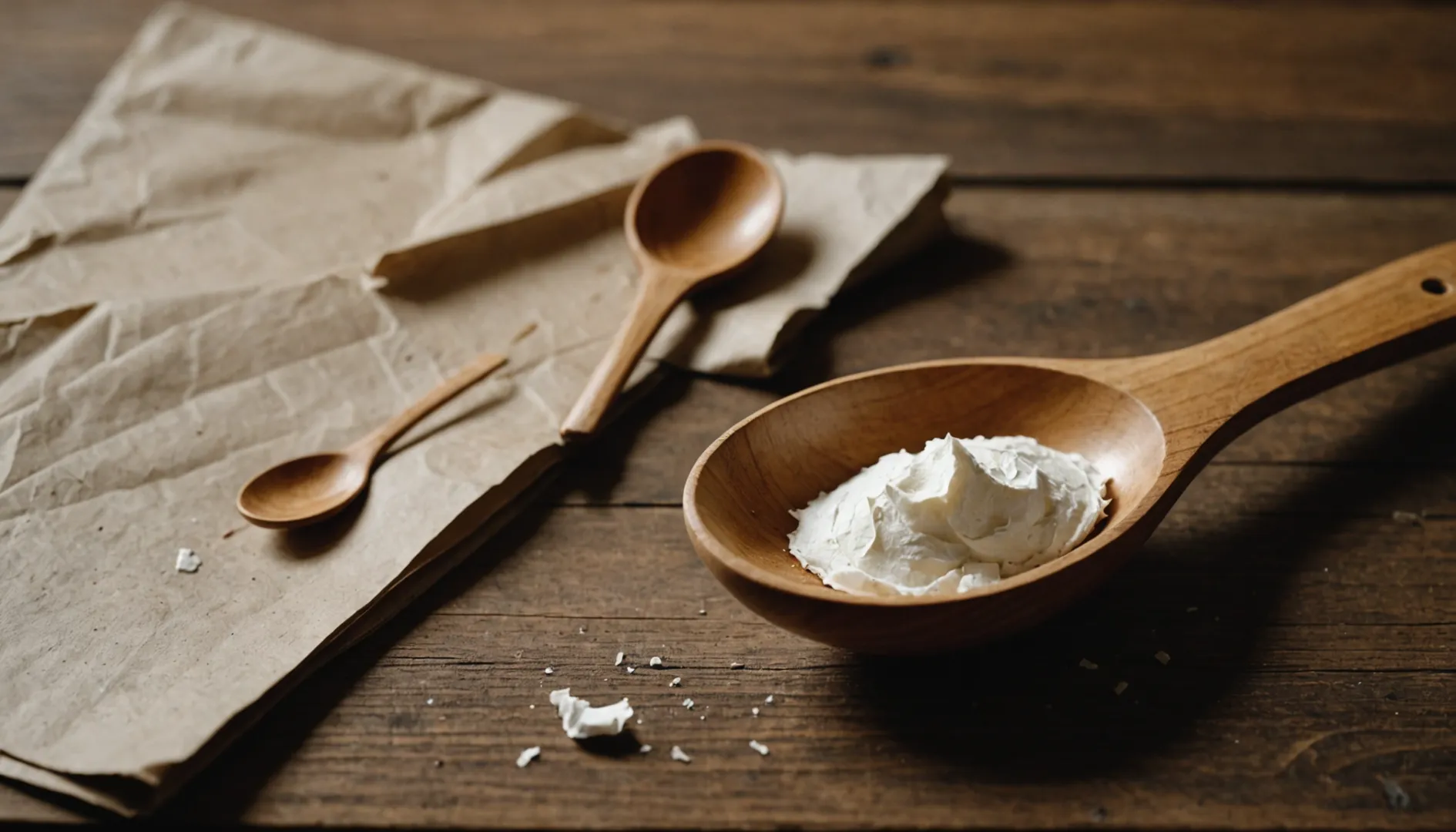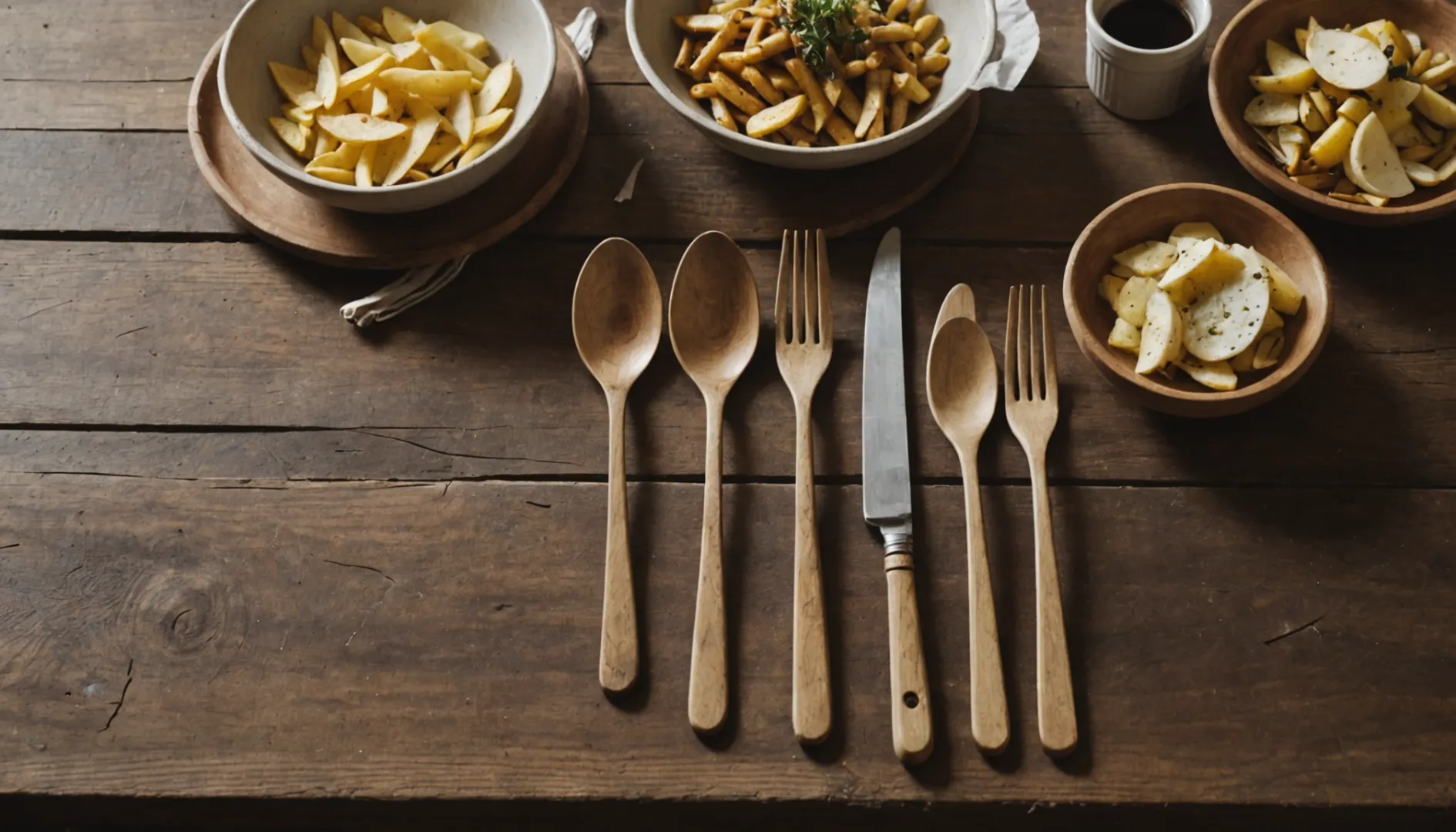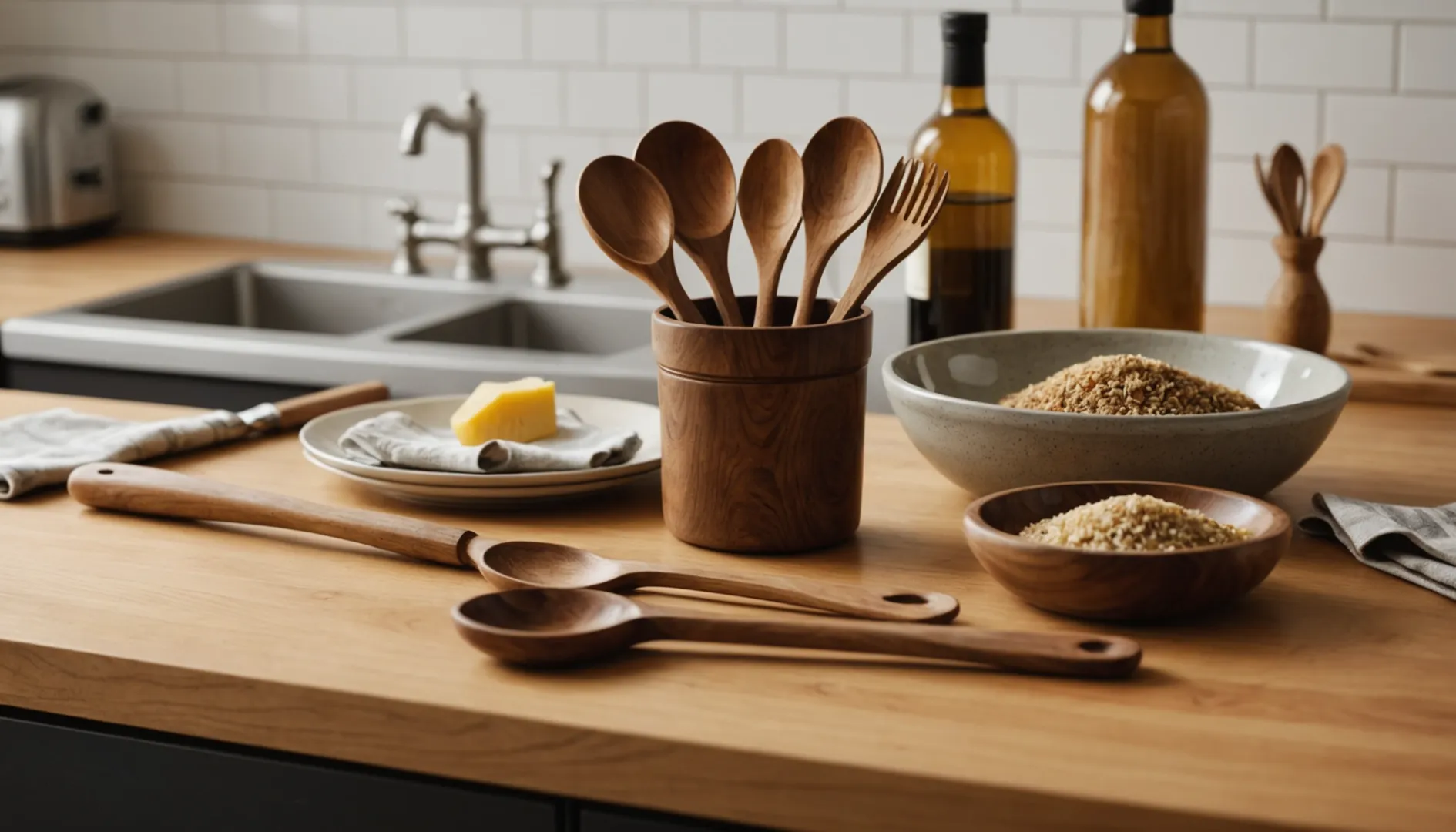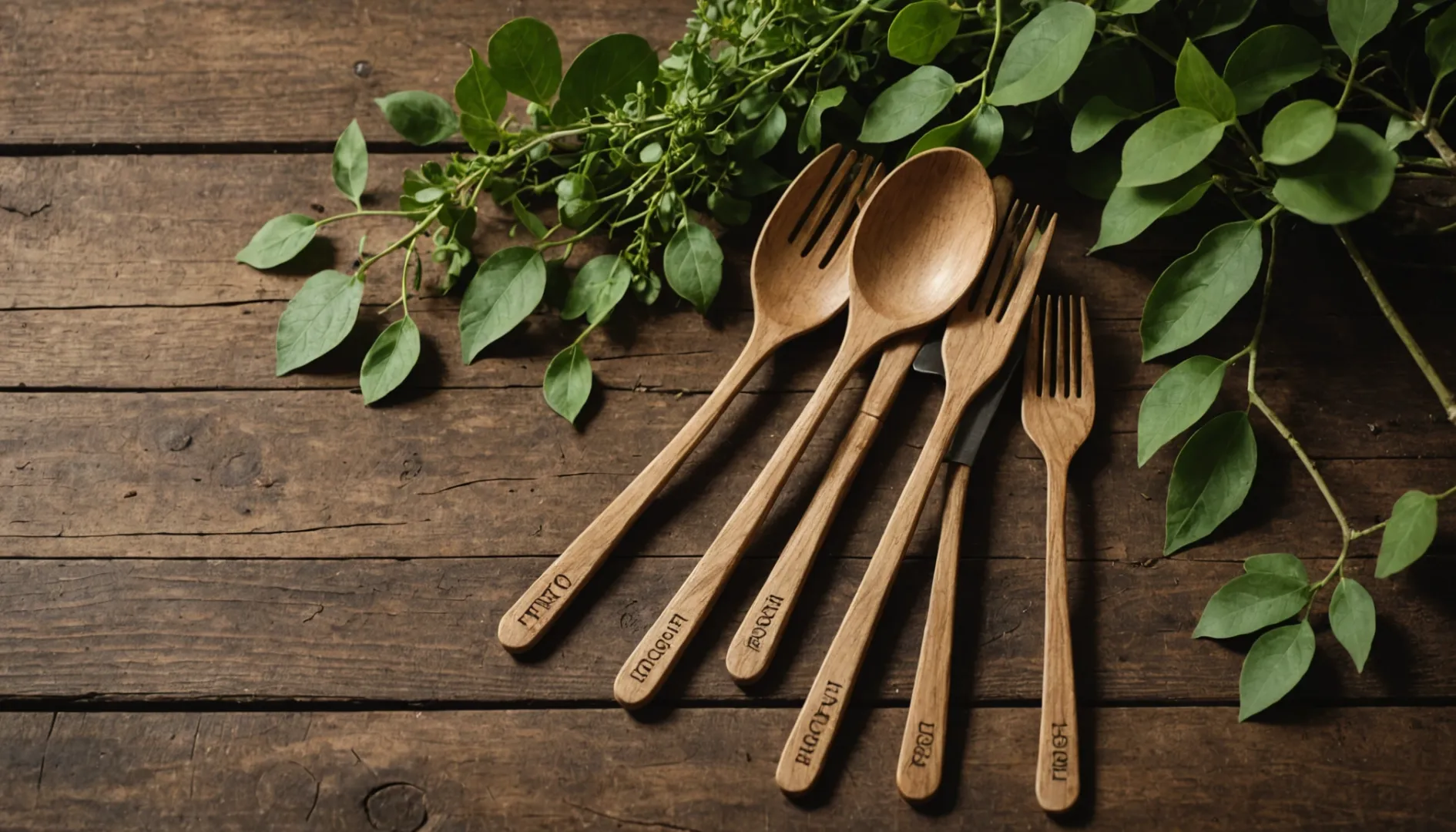
Are you contemplating the switch to disposable wooden cutlery? If you’re wondering whether it truly outshines paper-based options, you’re not alone!
Disposable wooden cutlery provides superior durability and environmental benefits over paper-based options. Wooden utensils are biodegradable, sturdier, and offer a natural aesthetic, making them an ideal choice for eco-friendly dining experiences.
While this gives a quick overview, there are deeper insights into why wooden cutlery stands out as the more sustainable and practical option. From its robust design to its eco-certification standards, let's explore how wooden cutlery holds up in the quest for sustainability.
Wooden cutlery is more durable than paper-based options.True
Wooden utensils resist moisture and wear, maintaining sturdiness, unlike paper cutlery.
How Does Wooden Cutlery Compare in Durability to Paper-Based Options?
Curious about whether wooden cutlery outlasts paper-based utensils? Let's break down the differences.
Wooden cutlery is generally more durable than paper-based options, offering better resistance to moisture and wear. While paper cutlery can become soggy and lose structural integrity when wet, wooden utensils maintain their sturdiness, making them a more reliable choice for various dining experiences.

Wooden Cutlery: Strength and Sustainability
When it comes to durability1, wooden cutlery emerges as a front-runner. Constructed from hardwoods like maple or oak, these utensils are naturally robust. They are designed to withstand moderate heat and resist moisture, unlike paper cutlery, which tends to absorb liquids and weaken over time. This makes wooden cutlery a superior choice for serving foods that are saucy or have high moisture content.
Challenges with Paper-Based Utensils
Paper-based cutlery, while eco-friendly, faces significant durability challenges. Upon contact with liquids, paper utensils can soften and lose their shape. This often results in a compromised dining experience, particularly in settings where the food is warm or moist. Despite being biodegradable and lightweight, the longevity of paper cutlery is limited to dry applications.
Comparing Resistance to Environmental Factors
Let's examine how these materials hold up under various conditions:
| Feature | Wooden Cutlery | Paper-Based Cutlery |
|---|---|---|
| Moisture Resistance | High | Low |
| Heat Resistance | Moderate | Low |
| Biodegradability | Yes | Yes |
| Aesthetic Appeal | Natural, rustic look | Simple, can be customized |
| Longevity | Can last for multiple uses | Single-use, especially if wet |
Maintenance and Longevity
The lifespan of wooden cutlery can be extended with proper care. Regular oiling and avoiding prolonged exposure to water enhance their durability. On the other hand, paper cutlery requires no maintenance but offers only single-use practicality in most cases.
Practical Applications
In settings such as picnics, outdoor events, or eco-conscious restaurants, wooden utensils are preferred due to their sturdiness and ability to handle a variety of foods without compromising on usability. In contrast, paper cutlery is better suited for dry snacks or settings where the environmental impact is the primary concern over durability.
Overall, the choice between wooden and paper-based cutlery often depends on the specific needs of the user, weighing factors like environmental considerations2 against functionality.
Wooden cutlery is more durable than paper-based options.True
Wooden utensils resist moisture and wear better than paper ones.
Paper cutlery is more heat-resistant than wooden cutlery.False
Paper cutlery has low heat resistance, unlike wooden options.
What Is the Environmental Impact of Wooden Versus Paper Cutlery?
Are you torn between choosing wooden or paper cutlery for your next eco-friendly event? Let's explore their environmental footprints.
Wooden cutlery offers a more sustainable option than paper cutlery due to its biodegradability, minimal waste production, and responsible sourcing. Paper cutlery, while also biodegradable, often requires energy-intensive production processes and may not decompose as effectively if treated with coatings.

Biodegradability and Decomposition
When evaluating the environmental impact3 of cutlery, biodegradability is a key factor. Wooden cutlery tends to break down more naturally and quickly than many paper-based options. Wood is inherently biodegradable, provided it is untreated or coated with non-toxic substances like beeswax. Composting wooden utensils can enrich soil health and reduce landfill waste.
In contrast, paper cutlery often undergoes treatment to enhance durability and moisture resistance, which can impede its ability to decompose. While paper is generally considered biodegradable, these coatings may prolong its breakdown time, especially in landfill conditions.
Production and Resource Utilization
The production process for wooden cutlery involves sourcing wood from sustainable forests. This ensures that deforestation is minimized, and the ecological balance is maintained. The production of wooden utensils typically uses less energy than plastic or metal alternatives, but it still requires careful management to avoid wastage.
Paper cutlery, on the other hand, involves pulping and forming processes that are energy-intensive. The water and chemicals used in paper production can pose environmental hazards if not managed correctly. Additionally, while paper products are recyclable, the recycling process can be complicated by any additional coatings applied for durability.
| Material | Biodegradability | Resource Use | Production Impact |
|---|---|---|---|
| Wooden | High | Low | Moderate |
| Paper | Moderate | Moderate | High |
Lifecycle Analysis
A comprehensive lifecycle analysis (LCA) reveals that wooden cutlery typically has a smaller environmental footprint compared to paper alternatives. This is due to the reduced energy consumption in its production and its potential for longer-term reuse before disposal.
LCAs take into account every stage of a product’s life, from raw material extraction to manufacturing, distribution, use, and final disposal. For wooden cutlery, responsibly managed forests ensure that trees are replanted, maintaining the carbon cycle. In contrast, the pulp and paper industry can contribute significantly to greenhouse gas emissions if not carefully regulated.
Conclusion
While both wooden and paper cutlery have their merits, wooden utensils generally offer a more sustainable option. Their biodegradability and the potential for responsible sourcing make them a preferable choice for environmentally conscious consumers looking to minimize their carbon footprint.
The choice between wooden and paper cutlery will depend on specific needs and environmental priorities. However, with growing awareness around sustainability, the edge often leans towards wood for its natural appeal and lower overall environmental impact.
Wooden cutlery is more biodegradable than paper cutlery.True
Wooden cutlery breaks down naturally and quickly, unlike coated paper.
Paper cutlery production uses less energy than wooden cutlery.False
Paper cutlery production is energy-intensive due to pulping processes.
Are There Safety and Hygiene Considerations with Wooden Utensils?
Wooden utensils offer a rustic charm, but are they safe and hygienic compared to modern materials?
Yes, wooden utensils can be safe and hygienic if properly maintained. They require regular cleaning, drying, and oil treatment to prevent bacterial growth and ensure longevity.

The Porous Nature of Wood
One of the primary safety concerns with wooden utensils is their porous nature. Unlike plastic or metal, wood is prone to absorbing moisture, which can lead to bacterial buildup if not properly cared for. To mitigate this, many manufacturers apply natural coatings, such as beeswax or plant oils, to create a moisture-resistant barrier. Over time, these finishes may wear off, requiring reapplication to maintain effectiveness.
Proper Cleaning and Maintenance
Regular cleaning is crucial to ensure wooden utensils remain hygienic. They should be hand-washed with mild soap and warm water, avoiding prolonged soaking. After washing, it’s important to dry them immediately with a cloth to prevent warping or cracking. High heat can weaken the structure of wood, so it's best to keep them away from dishwashers and direct sunlight.
| Cleaning Tip | Explanation |
|---|---|
| Use Mild Soap | Prevents harsh chemical residues |
| Hand Wash Only | Protects the wood's integrity |
| Dry Immediately | Avoids swelling and cracking |
Natural Antibacterial Properties
Interestingly, wood possesses natural antibacterial properties. Studies suggest that certain types of wood can kill bacteria more effectively than plastic surfaces. This makes wooden utensils potentially safer for food contact when properly maintained.
Regular Oil Treatment
To extend the life and hygiene of wooden utensils, regular oil treatments are recommended. Food-safe oils, like mineral or coconut oil, can help maintain their finish and prevent cracking. Oiling also reduces the likelihood of splinters and keeps the surface smooth.
The Eco-Friendly Angle
Beyond hygiene, wooden utensils are an eco-friendly choice. They are biodegradable and, when sourced responsibly, have a lower environmental impact than plastic. Consumers should look for products with certifications like FSC (Forest Stewardship Council), ensuring sustainable practices.
While wooden utensils offer several benefits, their maintenance is key to ensuring they remain safe and hygienic options for daily use. Learn about natural coatings for wooden utensils4 that enhance durability and safety.
Wooden utensils can harbor bacteria if not maintained.True
Wood's porous nature can absorb moisture, leading to bacterial buildup.
All wooden utensils are dishwasher safe.False
Dishwashers can damage wood, causing warping or cracking.
Why Is Eco-Certification Important for Wooden Cutlery?
In an era where sustainability is paramount, eco-certification for wooden cutlery ensures responsible sourcing and production practices, enhancing credibility in the marketplace.
Eco-certification of wooden cutlery guarantees sustainable sourcing and manufacturing processes. Certifications like FSC and FDA provide assurance of quality, safety, and environmental responsibility, helping consumers make informed choices while supporting ethical brands.

Ensuring Sustainable Sourcing
Eco-certification plays a crucial role in verifying that the wood used in cutlery is sourced from responsibly managed forests. Certifications like the Forest Stewardship Council (FSC) ensure that the materials come from sustainable sources, minimizing deforestation impacts. This not only preserves biodiversity but also supports forest communities by promoting ethical labor practices.
Verifying Safety Standards
Certifications such as the Food and Drug Administration (FDA) and LFGB in Europe confirm that wooden cutlery is safe for food contact. These standards ensure that the utensils are free from harmful chemicals and coatings, which is vital given their direct interaction with food. By adhering to these guidelines, manufacturers can protect consumers from potential health risks.
Enhancing Market Credibility
For brands, eco-certification provides a competitive edge in eco-conscious markets. Consumers increasingly prefer products that demonstrate environmental responsibility. Life Cycle Analysis5 (LCA) can further enhance a brand's credibility by providing measurable data on energy and resource usage throughout the product's life cycle.
Supporting Transparency and Traceability
Transparency in the supply chain is becoming a priority for consumers. Technologies like blockchain can verify the origins of materials, ensuring they are sustainably and legally harvested. This transparency builds trust and aligns with growing consumer expectations for ethical products. Blockchain in supply chains6 offers a way for companies to share this verifiable information with customers.
Facilitating Eco-Friendly Innovations
Eco-certifications encourage innovations such as compostable coatings and efficient manufacturing processes that reduce waste. For example, some companies are exploring combinations with bamboo fiber to enhance strength while maintaining eco-friendliness. These innovations ensure that the products are not only sustainable but also meet functional needs effectively.
Encouraging Informed Consumer Choices
By providing clear labeling and certification marks, consumers can make informed choices. Brands that communicate their certifications effectively can educate consumers about the importance of sustainable practices and encourage more responsible purchasing decisions. This is particularly effective in regions with stringent environmental regulations like Europe and North America.
Eco-certification ensures sustainable wood sourcing.True
Certifications like FSC verify wood is from responsibly managed forests.
FDA certification is unnecessary for wooden cutlery.False
FDA ensures cutlery is safe for food contact, free from harmful chemicals.
Conclusion
Choosing wooden cutlery over paper-based options enhances sustainability while providing a reliable dining experience. Reflect on your choices today and opt for quality that cares for our planet.
-
Explore detailed comparisons on material strength and usage scenarios.: Wood is often considered the best material option for disposable cutlery, but the case is more complex. Read on our blog! ↩
-
Understand the ecological footprint of each material type.: The biggest upside of using wood to replace plastic cutlery is that it's a natural, renewable material. This means no fossil-based ingredients are needed to ... ↩
-
Discover insights into why wooden cutlery is often more sustainable.: The biggest upside of using wood to replace plastic cutlery is that it's a natural, renewable material. This means no fossil-based ingredients are needed to ... ↩
-
Discover coatings that improve durability and hygiene of wooden utensils.: Widely used in this application for centuries, linseed and walnut are natural oils that can create a very durable wood finish, almost like a ... ↩
-
Learn how Life Cycle Analysis boosts brand credibility through data transparency.: A Life Cycle Assessment (LCA) calculates the environmental impact of products or services throughout their entire lifecycle. ↩
-
Explore how blockchain ensures product authenticity from source to sale.: Blockchain can greatly improve supply chains by enabling faster and more cost-efficient delivery of products, enhancing products' traceability, improving ... ↩

